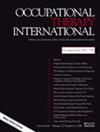The Impact of Weighted Blanket Use on Adults with Sensory Sensitivity and Insomnia
IF 0.9
4区 医学
Q3 REHABILITATION
引用次数: 0
Abstract
Purpose. This study’s purpose was to determine the impact of weighted blanket use on moderate to severe insomnia in adults with sensory sensitivity greater than the average population. Methods. For this study, a four-week, single-case, multiple-participant ABA study design was used. Through convenience sampling, four participants scoring 15 or greater on the Insomnia Severity Index (ISI), which categorizes them as having moderate to severe insomnia, and much more than most people in sensory sensitivity on the Adolescent/Adult Sensory Profile were recruited. First, seven-day baseline sleep data was gathered, followed by two weeks of weighted blanket use, concluding with a seven-day withdrawal phase. Additional outcome measures included: Tuck and Snooze Survey, Consensus Sleep Diary Morning, and Additional Sleep Diary Questions. Data analysis included visual analysis, mean comparisons, Tau- calculations, and pre- to post-ISI category comparisons. Results. All participants’ ISI scores were categorized as one level less severe postintervention. All participants demonstrated increased sleep quality, and three participants showed an increase in sleep duration based on individual mean comparisons between baseline and intervention phases. Conclusion. Weighted blankets appear beneficial in reducing insomnia severity in adults with much more than the average population sensory sensitivity. In addition, those with self-reported anxiety may have increased benefit from this intervention.使用配重毯对感官敏感和失眠成人的影响
研究目的本研究旨在确定使用加重毯对感官敏感度高于普通人群的成人中度至重度失眠症的影响。研究方法本研究采用了为期四周、单案例、多参与者的 ABA 研究设计。通过便利抽样,招募了四名失眠严重程度指数(ISI)达到或超过 15 分的参与者,他们被归类为中度至重度失眠者,在青少年/成人感官档案中,他们的感官敏感度远高于大多数人。首先,收集七天的基线睡眠数据,然后使用两周的加权毯,最后是七天的停用阶段。其他结果测量包括收腹和打盹调查、共识睡眠日记早晨和附加睡眠日记问题。数据分析包括视觉分析、平均值比较、Tau-计算以及使用前与使用后的ISI类别比较。结果。干预后,所有参与者的 ISI 评分都降低了一个等级。根据基线和干预阶段的个人平均值比较,所有参与者的睡眠质量都有所提高,三名参与者的睡眠时间也有所延长。结论对于感官敏感度远高于普通人群的成年人来说,配重毯似乎有利于减轻失眠的严重程度。此外,那些自述有焦虑症的人可能会从这种干预中获得更多益处。
本文章由计算机程序翻译,如有差异,请以英文原文为准。
求助全文
约1分钟内获得全文
求助全文
来源期刊

Occupational Therapy International
REHABILITATION-
CiteScore
2.50
自引率
6.70%
发文量
121
审稿时长
>12 weeks
期刊介绍:
Occupational Therapy International is a peer-reviewed journal, publishing manuscripts that reflect the practice of occupational therapy throughout the world. Research studies or original concept papers are considered for publication. Priority for publication will be given to research studies that provide recommendations for evidence-based practice and demonstrate the effectiveness of a specific treatment method. Single subject case studies evaluating treatment effectiveness are also encouraged. Other topics that are appropriate for the journal include reliability and validity of clinical instruments, assistive technology, community rehabilitation, cultural comparisons, health promotion and wellness.
 求助内容:
求助内容: 应助结果提醒方式:
应助结果提醒方式:


